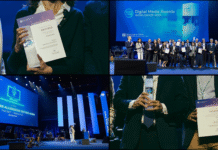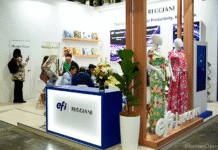Printing has gone beyond plain vanilla text and pictures and there is a huge demand for decorative add-ons such as glossy and enhanced visual effects, embossing, and customized embellishments – giving rise to new and diverse businesses.
Decorative technology, especially, is driving the overall print industry and related businesses — revolutionizing the printing landscape, offering enhanced visual appeal, customization options, and cost-effective production. A host of companies such as Jetsci Global, Scodix, Konica Minolta, Ricoh, and others offer new features and digital printing machines that can do wonders with techniques such as UV printing, screen printing, foiling, embossing, and embellishments.
UV printing
UV printing is a technique that uses ultraviolet light to dry or cure the ink during the printing process. The ink is exposed to UV light, which instantly dries and hardens it, resulting in a high-quality and durable print. UV printing offers vibrant colors, sharp details, and a glossy finish. It is commonly used for applications such as business cards, brochures, signage, packaging, and more.
Priyanka Rathi, DGM, marketing & communications at Jetsci Global, which offers UV printing and other solutions, says, “Spot UV allows for selective gloss or matte finishes, adding depth and texture to printed materials. It brings attention to specific areas, making designs more impactful and captivating. Screen printing, on the other hand, offers versatility in printing on various surfaces and substrates, enabling businesses to explore new markets and expand their offerings.”
Foiling and embellishments
“Foiling and embellishments provide a touch of luxury and sophistication to printed materials. They create eye-catching effects that elevate brand identity and enhance product packaging. With digital foiling, businesses can achieve intricate designs and patterns without the need for expensive dies or plates,” Rathi adds.
Foiling, also known as foil stamping or hot stamping, is a process that adds a metallic or glossy effect to printed materials. It involves applying a thin layer of metallic foil, often gold, silver, or copper, to specific areas of a design. Foiling can create eye-catching accents, highlights, or text on items such as business cards, invitations, packaging, certificates, and luxury product labels. The foil is applied using heat and pressure, resulting in a shiny and reflective finish.

Embellishments refer to decorative elements added to printed materials to enhance their visual appeal and create a more engaging experience. They can include various techniques such as embossing, debossing, die-cutting, spot varnishing, or using textured papers.
Embossing and debossing involve creating raised or recessed patterns or textures on the paper by applying pressure. Die-cutting involves cutting paper or cardstock into custom shapes. Spot varnishing applies a glossy or matte coating to specific areas of a design, creating contrast and texture.
These techniques are often used in combination to create visually striking and luxurious print products. They add depth, texture, and a premium look to the design, making the printed materials stand out and leave a memorable impression on the recipients.
Advancing solutions
According to Rathi, the print industry will witness further advancements in digital solutions and the emerging technologies will unlock endless possibilities, enabling businesses to stay competitive and meet evolving customer demands.
Naman Thoshniwal of Bhilwara-based Mudit Printers, who recently installed a PixelGlow digital UV and foiling machine, said spot UV, foiling, and embellishments take quality to a new level. “After getting this cost-effective digital print enhancement machine from Monotech Systems, we are capable and confident of varnishing and embellishing our printed products for added visual appeal, which we have never done before.”
To get a better perspective, Indian Printer and Publisher visited Chawri Bazaar, Delhi’s hub of wedding cards located behind the historic Jama Masjid in Old Delhi. The prices can range from as low as Rs 10 a piece for a plain card with text to a few thousand rupees for the highly decorative ones that are embossed with motifs and embellishments. The shop owners claim that without decorative technology, there was no way to make wedding cards exciting. Not just wedding cards, but even visiting cards, letterheads, greeting cards, and packaging and gifting have had a much better appeal due to decorative technology.
Diverse businesses
These technologies are also an enabler for diverse businesses. With the installation of a Ricoh Pro C7200x digital press, Inspackt, a paper & board packaging solution company, eyed short-run business with digital packaging. The director of the company, Yogesh Mehra said, “With a digital press, I don’t have to think as much about spending in comparison to an offset printer. We are able to match the metallic and Pantone finish requirement with Ricoh’s digital printing. UV printing, foiling, and embellishment go well in hand with our monocartons for food, pharma, and office stationary businesses.”
Then there are others like Andheri East-based Bombay Enterprise, who have opted for Konica Minolta’s MGI embellishment presses, which the company also displayed at Consumer Electronic Imaging Fair 2023 Mumbai. Bombay Enterprise installed a brand new MGI Accurioshine 3600 to meet the rising demand for post-print value-addition work in suburban Mumbai. This was the first MGI press – which comes with an offline foiling unit – to be commissioned in Mumbai’s suburbs. The other two are based in the south-central Mumbai business district of Lower Parel, the Indian Printer and Publisher’s Shardul Sharma had earlier reported.
“The demand for post-print enhancement work is strong and growing. We do enhancement jobs for our own in-house prints as well as for third-party printers, both offset and digital,” says Dipu who manages the operations with his father.
Mature market
Vijay Kamat of Konica Minolta had told Indian Printer and Publisher last year that the post-print enhancement market has matured in the last three to four years with installations happening in tier-II cities. “We have about 35 MGI installations in India. More customers in tier-II and tier-III cities are buying the MGI press. Recently, we sold an MGI press to a customer in Jaipur. We have installations in cities such as Nagpur, Nashik, and Lucknow. MGI has become a market leader in this segment,” Kamat said.
Scodix is another provider of digital enhancement solutions — highly detailed, short-run and data-variable personalized projects with tactile applications such as embossing, foil, metallic effects, glitter, and crystals — for the graphic arts industry, which it displayed at PrintPack India in May 2022. The Scodix Ultra 1000 series includes a large gamut of enhancement capabilities in the industry. These include Scodix Foil, Scodix VDE, Scodix Cast&Cure, and Scodix Crystal. Scodix’s customers scored big at this year’s 30th Annual Gold Leaf Awards, held during the Print Embellishment Conference organized by the Foil and Specialty Effects Association (FSEA) in Indianapolis, Indiana.


















